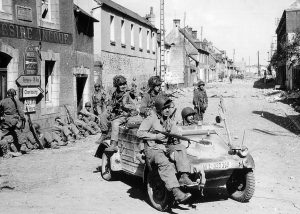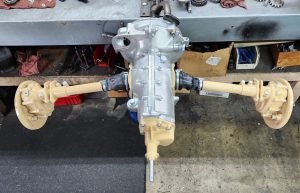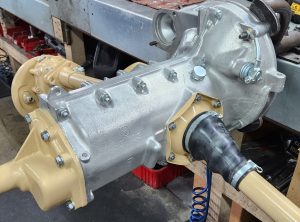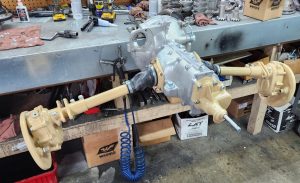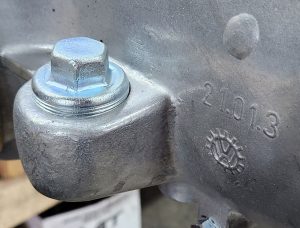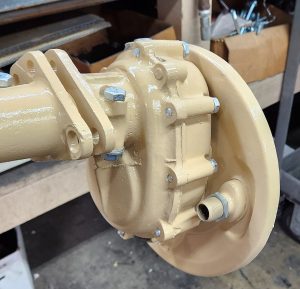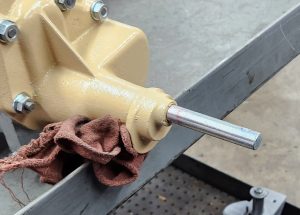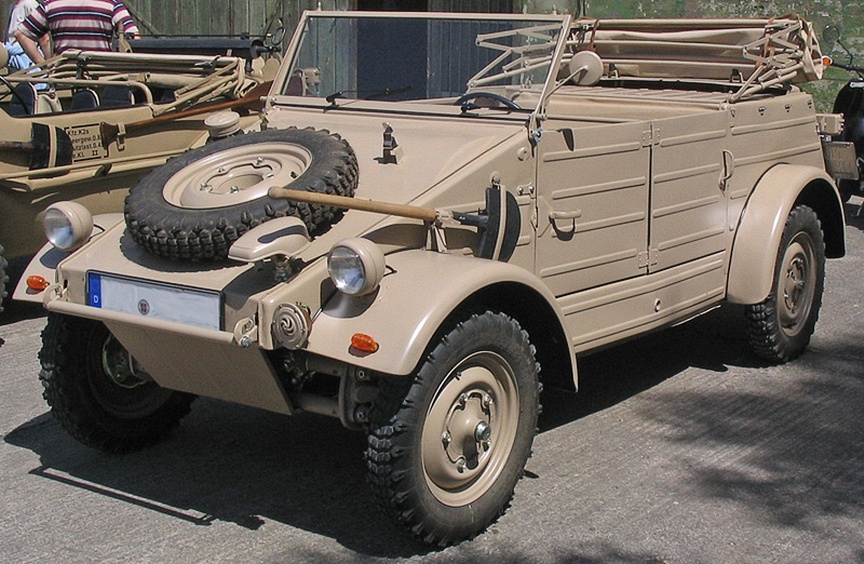
30 Jun Kubelwagen
Whenever something really special comes through the door at Rancho, Mike Herbert is the go-to guy. Recently Mike buzzed my phone and told me he had just buttoned-up a full restore on one of the elusive Kubelwagen transaxles. Grabbed a camera and here are the results along with a brief history of the historical vehicles I found on Wikipedia.
Although Adolf Hitler discussed with Ferdinand Porsche the possibility of military application of the Volkswagen as early as April 1934, it was not until January 1938 that high-ranking Heereswaffenamt officials formally approached Porsche about designing an inexpensive, lightweight military transport vehicle that could operate reliably both on- and off-road, in even the most extreme conditions. This implied that the Beetle could provide the basis for such a vehicle.
Porsche began work on the project immediately, having a prototype of the vehicle ready within the month, but realized during development that it would not be enough to just reinforce the Beetle’s chassis to handle the stresses that military use would place on it. In order to guarantee adequate off-road performance of a two-wheel-drive vehicle with a 1,000 cc FMCV 1 engine, it would have to be lightweight. In fact, the army had stipulated a gross weight of 950 kg (2,090 lb), including four battle-dressed troops, which meant that the vehicle itself should not weigh more than 550 kg (1,210 lb). Porsche therefore sub-contracted Trutz, an experienced military coachbuilder, to help out with the body design.
Developmental testing by the military began after a presentation of the prototypes designated as Type 62 in November 1938. Despite lacking four wheel drive, the vehicle proved very competent at maneuvering its way over rough terrain, even in a direct comparison with a contemporary standard German Army 4×4, and the project was given the green light for further development. The vehicle’s light weight and ZF self-locking differential compensated for the lack of a four-wheel drive.
Further development of the Type 62 took place during 1939, including a more angular body design, and pre-production models were field-tested in the invasion of Poland that started in September that year. Despite their overall satisfaction with the vehicle’s performance, military commanders demanded a few important changes: the lowest speed of the vehicle had to be reduced from 8 km/h (5.0 mph) to 4 km/h (2.5 mph) as an adjustment to the marching pace of soldiers.[a] Second, it needed some further improvement of its cross-country mobility. Porsche responded to both requests by mounting new axles with gear-reduction hubs, providing the car with more torque while at the same time increasing its ground clearance. Revised dampers, 41 cm (16 in) wheels, and a limited-slip differential, as well as countless small modifications completed the specification. In order to reflect the changes, the vehicle was renamed Type 82.
Full-scale production of the Type 82 Kübelwagen started in February 1940, as soon as the VW factories had become operational. No major changes took place before production ended in 1945, only small modifications were implemented, mostly eliminating unnecessary parts and reinforcing others which had proved unequal to the task. Prototype versions were assembled with four-wheel-drive (Type 86) and different engines, but none offered a significant increase in performance or capability over the existing Type 82, so these designs went nowhere. As of March 1943, the car received a revised dash and the bigger 1,131 cc engine, developed for the Schwimmwagen, that produced more torque and power than the original 985 cc unit. When Volkswagen production ceased at the end of the war, 50,435 Kübelwagen vehicles had been produced,[8] and the vehicle had proven to be surprisingly useful, reliable, and durable.
Wolfsburg lies in the British occupation zone, close to the border of the
Soviet German zone[b] —
The American zone and the French had the south.
Post-war
Upon conquest of Germany by the Allies, the country was occupied in four sectors: a U.S., Soviet, U.K. and French sector respectively, and the massive Volkswagen factory and the town built for its workers, Wolfsburg, fell into the British sector. U.K. Major Ivan Hirst was put in charge of the factory and workers. He is largely credited with production resuming, and reopening the VW factory. He organized the clearance of bomb damage, and had the buildings repaired. He recommissioned machine tools, body presses and assembly jigs; he concerned himself with improving the quality of the civilian car, including starting a sales and service network and starting exports.[1] Despite a damning report of Volkswagens by engineers from the British Rootes Group stating that: “the vehicle does not meet the fundamental technical requirement of a motorcar…”, the British Army thought differently. When a surviving wartime Volkswagen was demonstrated to the British Rhine Army Group headquarters, the U.K. military ordered a batch of 20,000 similar vehicles. By the end of 1945, the factory had somehow managed to put together 2,490 cars. Many of them were then bartered in exchange for materials to make more cars. Hirst turned production around to export civilian Volkswagens; the first export went to the Netherlands in 1947.[1]
Long after the end of the war, VW resurrected the basic Kübelwagen design as the 1969 Type 181, developed for the German Federal Armed Forces and later also produced this model for the civilian market, which was known as “Thing” in the US, “Trekker” in the UK, and “Safari” in Mexico. Although similar in looks and design, almost no parts were interchangeable with the original Type 82.
Intermeccanica of Canada has been producing a Kubelwagen replica since 1995.[9][10]
Technology and performance
A Kübel seized by American paratroopers in Carentan during the Battle of Normandy, 1944
When the German military took delivery of the first vehicles, it immediately put them to the test on- and off-road in snow and ice to test their capability at handling European winters. Several four-wheel-drive vehicles were used as reference points. The two-wheel-drive Kübelwagen surprised even those who had been a part of its development, as it easily out-performed the other vehicles in nearly every test. Most notably, thanks to its smooth, flat underbody, the Kübel would propel itself much like a motorised sled when the wheels sank into sand, snow, or mud, allowing it to follow tracked vehicles with remarkable tenacity.
In November 1943, the U.S. military conducted a series of tests as well on one or several Type 82s it had captured in North Africa campaign. This evaluation, done at the Army’s Aberdeen Proving Ground, resulted in the publication of War Department Technical Manual TM E9-803, 6 June 1944 (on D-Day). The manual’s publication date (D-Day) is assumed to be coincidental, but its TM number was identical to that of the American jeep, with the prefix ‘E’ for ‘enemy’. It was intended for distribution after the 6 June invasion of Normandy to US military personnel who might encounter ones that had been abandoned, possibly for lack of fuel or a minor technical problem, and with the help of this manual, might be put into service as additional vehicles. The TM calls the type 82 ‘a four-wheeled, rubbertyred, rear axle drive personnel carrier and reconnaissance car, comparable in purpose and size to the American 1/4 ton truck’.[1] So thorough was the analysis that it included information beyond what could be done as field servicing, plus ways of dealing with very low temperatures. U.S. War Department Technical Manual TM-E 30-451, Handbook on German Military Forces, (p. 416), states: “The Volkswagen, the German equivalent of the American “Jeep”, is inferior in every way except in the comfort of its seating accommodations.”[11] Nevertheless, VW Kübelwagens were so frequently captured, and deemed sufficiently useful, that the same U.S. War Department wrote and published an official Technical Manual TM E9-803 for it in June 1944, for the benefit of allied officers and troops.
Two-gear reduction (15:21 teeth) portal hub of the VW Type 82 Kübel
At the same time, another Kübelwagen, also captured in North Africa, had been dissected in Britain by engineers of the Humber Car Company, whose report said it exhibited no “special brilliance” in design except in details and that “it is suggested that it is not to be regarded as an example of first class modern design to be copied by British industry”.[12]
Among the design features that contributed to the Kübelwagen’s performance were:
Light weight. While it was some 41 cm (16 in) longer than the Willys MB, it weighed more than 300 kg (660 lb) less.
Very flat and smooth underbody that allowed the car to slide without snags over the surface it was traversing.
Considerable ground clearance, roughly 28 cm (11 in), in part thanks to:
The use of portal gear hub reduction, providing more torque and ride height simultaneously.
Independent suspension on all four wheels.
Self-locking differential, limiting slippage and retaining traction.
In addition, the air-cooled engine proved highly tolerant of hot and cold climates alike, and was less vulnerable to bullets due to the absence of a radiator. For starting under winter conditions, a special, highly volatile starting fuel was supplied from a small auxiliary tank.
As the body was not a load-bearing part of the structure of the vehicle, it could easily be modified to special purposes, just like the jeep’s.
The Kübelwagen, thanks to its geared hubs, could go as slow as marching troops 4 km/h (2.5 mph), yet reach a top speed of 80 km/h (50 mph).

